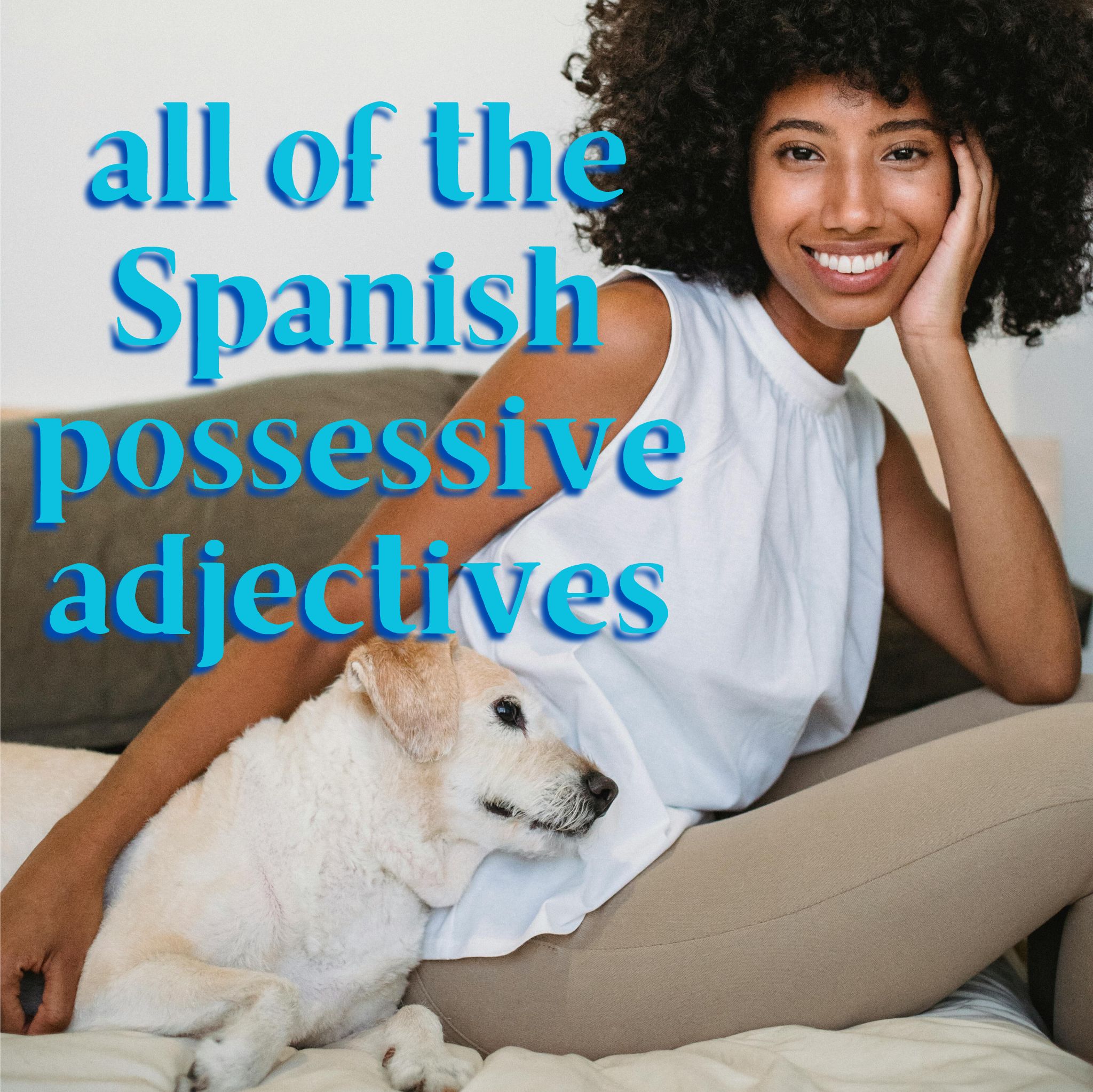All Spanish Possessive Adjectives: A detailed guide

Get our free email course, Shortcut to Conversational.
Have conversations faster, understand people when they speak fast, and other tested tips to learn faster.
More infoAre you ready for a full introduction to all the possessive adjectives in Spanish? We’ve already covered the easiest forms in our simple guide to expressing possession in Spanish, so today we’re going a lot deeper and covering all Spanish possessive adjectives.
We’ll see both the short-form and long-form possessive adjectives, and we’ll discuss how and when to use each form. We’ll also look at the distributive possessive adjective in Spanish, sendos, which doesn’t have an equivalent in English.
Of course, possessive adjectives are just one way of expressing possession. Check out our other posts for full lessons on using possessive pronouns, or on using de + owner to indicate someone’s object.
For today, let’s get started and learn everything there is to know about the Spanish possessive adjectives!
What are the possessive adjectives in Spanish?
You’re surely familiar with the English possessive adjectives: my, your, his, her, its, our, their. But what are the possessive adjectives in Spanish? Well, we have essentially the same ones, but in a few different forms. (We also have an additional one, sendos, which is known as a distributive possessive adjective in Spanish. We’ll introduce it near the end of this post.)
Just like in English, our Spanish possessive adjectives need to match the owner: my for I, your for you, our for we, and so on. A big difference is that we use the same possessive adjective in Spanish for each grammatical person, so there’s no differentiation between his, her, or its in Spanish, for example, nor even for your when we’re addressing usted.
- The boy eats his dinner. – El niño come su cena.
- The girl eats her dinner. – La niña come su cena.
- The dog eats its dinner. – El perro come su cena.
- You, sir, eat your dinner. – Usted, señor, coma su cena.
In addition, just like any other adjective in Spanish, each one needs to also match the gender and number of the possession. Some of possessive adjectives have only one form for masculine and feminine possessions, while others have two gender-specific forms. All Spanish possessive adjectives have a plural form that ends in -s. Here’s an example where we show all four forms of our in Spanish, which we can sum up as nuestro/a(s).
- This is our house. – Esta es nuestra casa.
- This is our car. – Este es nuestro auto.
- These are our daughters. – Estas son nuestras hijas.
- These are our cats. – Estos son nuestros gatos.
Finally, there are two distinct sets of Spanish possessive adjectives. The most common are known as short-form possessive adjectives, which resemble the ones you use in English. The other set are the long-form possessive adjectives, which aren’t as common and which work a bit differently.
- I like your dress. – Me gusta tu vestido. (short-form) – Me gusta el vestido tuyo. (long-form)
In the following two charts we present all possessive adjectives in Spanish, starting with the short-form and then seeing the long-form. We’ll move on to our explanations in the subsequent sections.
Short-form Spanish possessive adjectives
| English possessive adjective | Owner: subject pronoun | Masculine singular possessive adjective | Feminine singular possessive adjective | Masculine plural possessive adjective | Feminine plural possessive adjective |
| my | yo | mi | mi | mis | mis |
| your (singular informal) | tú | tu | tu | tus | tus |
| his, her, its, your (singular formal) | él, ella, usted | su | su | sus | sus |
| our | nosotros, nosotras | nuestro | nuestra | nuestros | nuestras |
| your (plural informal, Spain) | vosotros, vosotras | vuestro | vuestra | vuestros | vuestras |
| their, your (plural) | ellos, ellas, ustedes | su | su | sus | sus |
We can sum all these forms up with these abbreviations: mi(s), tu(s), su(s), nuestro/a(s), vuestro/a(s), su(s).
Note the difference between the second-person singular subject pronoun and possessive adjective: tú vs tu. Spanish accent marks change the meaning of words, so these two are distinct even if they’re pronounced identically.
Long-form Spanish possessive adjectives
| English possessive adjective | Owner: subject pronoun | Masculine singular possessive adjective | Feminine singular possessive adjective | Masculine plural possessive adjective | Feminine plural possessive adjective |
| my | yo | mío | mía | míos | mías |
| your (singular informal) | tú | tuyo | tuya | tuyos | tuyas |
| his, her, its, your (singular formal) | él, ella, usted | suyo | suya | suyos | suyas |
| our | nosotros, nosotras | nuestro | nuestra | nuestros | nuestros |
| your (plural informal, Spain) | vosotros, vosotras | vuestro | vuestra | vuestros | vuestros |
| their, your (plural) | ellos, ellas, ustedes | suyo | suya | suyos | suyas |
We can sum up all these forms in the following list: mío/a(s), tuyo/a(s), suyo/a(s), nuestro/a(s), vuestro/a(s), suyo/a(s). In the table above, we bolded the specific endings that correspond with the gender and number of the possessions.
Ok, now that we’ve seen each Spanish possessive adjectives chart for the two types, let’s move on to see how we use them!
How to use possessive adjectives in Spanish
We’ve just seen the two different forms of Spanish possessive adjectives, and each one is used a bit differently. The short-form versions are the most common, and can be used 100% of the time. We’ll start with them, and then move on to the long-form possessive versions to see how they’re used differently.
Short-form possessive adjectives in Spanish
These are the Spanish possessive adjectives most people think of. They’re used easily to indicate possession, without putting any particular stress on the owner. For this reason they’re also sometimes called unstressed possessive adjectives in Spanish.
Short-form possessive adjectives are placed before the noun they modify. In this sense they’re very similar to their English conterparts, since they’re placed before the possessed object.
Most of the short-form possessive adjectives don’t exhibit different masculine and feminine forms between masculine and feminine possessions, so we just use mi(s), tu(s), and su(s) regardless of the gender of the possession. Nuestro and vuestro both have feminine forms, so we use nuestro(s) and vuestro(s) before masculine possessions, and nuestra(s) and vuestra(s) before feminine possessions.
All Spanish possessive adjectives have singular and plural forms: mi, tu, su, nuestro/a, and vuestro/a are used for singular possessions, while mis, tus, sus, nuestros/as, and vuestros/as are used for plural possessions.
Here’s another look at the short-form possessive adjectives in Spanish, organized by the grammatical person of the owner. The different forms of each reflect the gender and number of the possessions.
| Grammatical person | Singular owner | Plural owner |
| First-person owner | mi(s) | nuestro/a(s) |
| Second-person owner | tu(s) | vuestro/a(s) |
| Third-person owner | su(s) | su(s) |
Now we’re ready to see some examples using all of the short-form Spanish possessive adjectives:
- I gave all my old CDs to my kid. – Le di todos mis CD viejos a mi hijo.
- We will surely go to your birthday party on Saturday and bring your gifts. – Seguramente vamos a ir a tu fiesta de cumpleaños el sábado y llevaremos tus regalos.
- Welcome to my home. – Bienvenidos a mi hogar.
- Marcos is a writer, and his last book is awsome. – Marcos es escritor, y su último libro es genial.
- Our Christmases in Buenos Aires were always the best. – Nuestras Navidades en Buenos Aires eran siempre las mejores.
- Their dogs were the most beautiful in the neighborhood. – Sus perros era los más hermosos del barrio.
- We looked for our suitcases at the airport but we didn’t find them. – En el aeropuerto buscamos nuestras maletas pero no las encontramos.
- Where are your new gloves? – ¿Dónde están tus guantes nuevos?
Long-form possessive adjectives in Spanish
These forms are also called stressed possessive adjectives in Spanish, since they’re normally used to add emphasis.
Aside from this added stress, however, the meaning we convey when using long-form vs short-form possessive adjectives in Spanish is exactly the same. The only grammatical difference is in their sentence structure.
Just like we saw with the unstressed possessive adjectives, the stressed versions also have different forms to match the gender and number of the possessions. In contrast to mi(s), tu(s), and su(s), however, which don’t have different masculine and feminine forms, these all have four different versions: mío/a(s), tuyo/a(s), suyo/a(s), nuestro/a(s), vuestro/a(s), suyo/a(s).
The normal way to use long-form possessive adjectives is to add a definite article to the possession and follow it with the possessive adjective. Let’s see some examples to see how these work.
- My work is more fun than your hobby. – El trabajo míyo es más agradable que el hobby tuyo.
- They have to show their IDs before entering the country. – Tienen que mostrar las identificaciones suyas antes de ingresar al país.
- Our friend from Spain came to visit us today. – El amigo nuestro de España vino a visitarnos hoy.
Another common way to use the long-form possessive adjectives is to omit the noun when it’s evident. The best English translation uses a possessive pronoun in this case, but the Spanish version still technically uses the possessive adjective. We show the omitted possessions in square brackets in the following examples, but this structure sounds best without them.
- The ham sandwich is yours, the vegetarian one is mine. – El sandwich de jamón es [el sandwich] tuyo, el vegetariano es [el sandwich] mío.
When to use long-form over short-form possessive adjectives
In terms of meaning, we can use short-form or long-form possessive adjectives interchangeably: the underlying meaning remains the same. Short-form possessive adjectives are used the most, by far. So when is it preferable to use the long-form possessive adjectives?
It all comes down to emphasis. Whereas the short forms are simply used to state the facts, we use the long forms to really emphasize who the owner is.
Let’s see how this works with a few examples. The meanings of the following sentences may be the same, but when reading the long-form examples, just think about how the speaker might be emphasizing the identity of the owner.
- Please, give me your passport. – Por favor, deme su pasaporte. – Por favor, deme el pasaporte suyo.
- My daughter studies at harvard. – Mi hija estudia en Harvard. – La hija miya estudia en Harvard.
- Do you have my credit card? – ¿Tienes mi tarjeta de crédito? – ¿Tienes la tarjeta de crédito mía?
So what are the contexts where we opt for the long-form possessive adjectives over the short forms? In the first example, it’s likely a border control agent who’s processing a group as they enter the country, and asking for your passport now, please. In the second, the parent may have just heard which university their friend’s kid attends and wants to point out proudly the one where my daughter studies. In the last one, perhaps you have no pockets so your friend is carrying your cards in her wallet for you, and you just double-check before leaving that she indeed has my credit card in there.
Sure, the meaning is the same between the two versions, but if you truly want to emphasize who is responsible for something, opting for the long-form possessive adjectives in Spanish is the way to go. This is particularly evident in exclamations, where ownership is highlighted.
- My short story was chosen as the best story of the year! – ¡El cuento mío fue elegido como el mejor del año!
- Your daughter was shouting all night long! – ¡La hija tuya estuvo gritando toda la noche!
When not to use possessive adjectives in Spanish
In general, we use Spanish possessive adjectives in the same contexts as you use English ones. There’s a major exception, however, when we don’t use them: when talking about actions we do on or for ourselves.
In many such contexts, we use reflexive verbs referring to ourselves. To express possession in these cases, we use the reflexive pronoun before the verb, along with the definite article before the possession.
- He put his coat on and left. – Se puso el abrigo y se fue.
- She brushes her hair every morning. – Se cepilla el cabello cada mañana.
- My ear is itching. – Me pica la oreja.
Even without the use of reflexive verbs, when we’re talking about body parts or clothes we still use the definite article rather than the possessive adjective in Spanish.
- He closed his eyes before midnight. – Cerró los ojos antes de la medianoche.
- Martín dumped the snow out of his boots and then put his feet in. – Martín se sacó la nieve de las botas y luego metió las patas.
- Susana had a hole in her dress. – Susana tenía un agujero en el vestido.
Sendos/as: The distributive possessive adjective in Spanish
In addition to the regular possessive adjectives in Spanish we’ve seen so far, sendos is another possessive adjective that doesn’t have an equivalent in English. Sendos is considered a distributive possessive adjective. It takes the form sendos for masculine objects and sendas for feminine ones. It’s exclusively used with a plural subject to describe plural possessions, so the English translation is always their.
So when do we use sendos and sendas in Spanish? The point of these distributive adjectives is to say that each person in a group has their own individual objects: they have their objects. What’s special about sendos is that it conveys a one-to-one possession relationship between the owners and their objects, using a single distributive possessive adjective.
Let’s take a look at an example to see this in practice:
- The students attend the class with their workbooks. – Los estudiantes asisten a clase con sendos cuadernos.
By using sendos here rather than sus, we’re making it clear that each student has their own workbook, and that the number of workbooks is the same as the number of students. All the students have their workbooks.
- The students attend the class with their coffees. – Los estudiantes asisten a clase con sus cafés.
In this next sentence where we use sus as their in Spanish, we’re not making any correlation between the number of students and the number of coffees they bring. We look across the room and see many coffees on their desks, but we’re not saying that each student has one. We can’t use sendos in this case.
We’ll wrap up this section on sendos with a few more example sentences to see how it’s used.
- Pupils must attend the conference with their mothers. – Los estudiantes deben asistir a la conferencia con sendos madres.
- The gymnasts and their coaches line up for a photo. – Las gimnastas y sendos entrenadoras se alinean para una foto.
- Put away the games in their respective boxes. – Devuelve los juegos a sendas cajas.
Conclusion: Possessive adjectives in Spanish
Today we covered everything you need to know about Spanish possessive adjectives. Now you know what are the possessive adjectives in Spanish, as well as how to use them.
We first introduced the short-form possessive adjectives: mi(s), tu(s), su(s), nuestro/a(s) , vuestro/a(s), su(s). Then we saw the long-form, or stressed, possessive adjectives in Spanish: mío/a(s), tuyo/a(s), suyo/a(s), nuestro/a(s), vuestro/a(s), suyo/a(s).
Then we saw how and when to use them. The short forms are very similar to their English counterparts; the long forms are best when we want to really emphasize who the owner is. We also saw the contexts when we don’t use possessive adjectives in Spanish, namely for actions being done on oneself.
Finally, we introduced the distributive possessive adjective in Spanish: sendos. Always translating as their, the particularity of sendos and sendas is that it indicates a one-to-one distribution of owners to objects.
This was a very in-depth guide, but straightforward enough that you can easily come back and refer to it whenever you need a refresher. At this point, though, you should have an excellent grasp of all possessive adjectives in Spanish!
Exercises
Ready to see how well you’ve learned the Spanish possessive adjectives? Give these exercises a try by choosing the right one for each scenario! Remember to match the gender and number of the object correctly. The pronoun for the owner is indicated in parentheses for each question.
1. A ______ (yo) hermana, le gusta mucho ______ (ella) nuevo libro electrónico.
2. ¡Los gatos _____ (ellos) ensuciaron todo el jardín!
3. ¿Encontraste ______ (tú) zapatos?
4. El pastel ______ (ella) es delicioso, el ______ (nosotros) no tanto.
5. ______ (él) teléfono nuevo es muy moderno.
6. Los concursantes recibieron ______ (ellos) premios.
7. Encontramos _____ (usted) identificación en la calle.
Answers
1. A mi hermana, le gusta mucho su nuevo libro electrónico. – My sister loves her new e-book.
2. ¡Los gatos suyos ensuciaron todo el jardín! – Their cats messed up the whole garden!
3. ¿Encontraste tus zapatos? – Did you find your shoes?
4. El pastel suyo es delicioso, el nuestro no tanto. – Her cake is delicious, our [cake] not that much.
5. Su teléfono nuevo es muy moderno. – His new phone is really modern.
6. Los concursantes recibieron sendos premios. – The contestants received their awards.
7. Encontramos su identificación en la calle. – We found your ID on the street.



